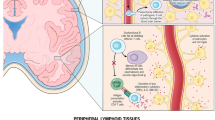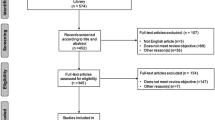Abstract
In multiple sclerosis (MS), inflammatory demyelination in the central nervous system is thought to be initiated by T cells that recognize myelin antigens. T cells are the main regulators of acquired immunity and are involved in the pathogenesis of several organ-specific autoimmune diseases. This review provides an overview of recent studies on the role of T cells in autoimmune demyelination. Because autoreactive T cells are normally present in the mature repertoire of T cells in the blood and lymphoid organs of MS patients, but also in normal controls, particular attention is devoted to the mechanisms of activation and the functional phenotype of such T cells in patients with MS. The role of cytokines as effector molecules and the main candidate antigens are also discussed.
Similar content being viewed by others
References and Recommended Reading
Martin R, McFarland HF: Immunological aspects of experimental allergic encephalomyelitis and multiple sclerosis. Crit Rev Clin Lab Sci 1995, 32:121–182.
Genain CP, Cannella B, Hauser SL, Raine CS: Identification of autoantibodies associated with myelin damage in multiple sclerosis. Nat Med 1999, 5:170–175.
Babbe H, Roers A, Waisman A, et al.: Clonal expansions of CD8(+) T cells dominate the T cell infiltrate in active multiple sclerosis lesions as shown by micromanipulation and single cell polymerase chain reaction. J Exp Med 2000, 192:393–404. This study analyzed the clonal composition and T-cell reactor repertoire of T cells infiltrating demyelinating multiple sclerosis (MS) lesions by micromanipulation and single-cell polymerase chain reaction. It provided the highest level of resolution available to date for the clonal analysis of brain-infiltrating T cells in MS.
Jurewicz A, Biddison WE, Antel JP: MHC class I-restricted lysis of human oligodendrocytes by myelin basic protein peptidespecific CD8 T lymphocytes. J Immunol 1998, 160:3056–3059.
Biddison WE, Cruikshank WW, Center DM, et al.: CD8+ myelin peptide-specific T cells can chemoattract CD4+ myelin peptide-specific T cells: importance of IFN-inducible protein 10. J Immunol 1998, 160:444–448.
Wekerle H, Bradl M, Linington C, et al.: The shaping of the brain-specific T lymphocyte repertoire in the thymus. Immunol Rev 1996, 149:231–243.
Soldan SS, Leist TP, Juhng KN, et al.: Increased lymphoproliferative response to human herpesvirus type 6A variant in multiple sclerosis patients. Ann Neurol 2000, 47:306–313.
Gran B, Hemmer B, Vergelli M, et al.: Molecular mimicry and multiple sclerosis: degenerate T-cell recognition and the induction of autoimmunity. Ann Neurol 1999, 45:559–567.
Fujinami RS, Oldstone MB: Amino acid homology between the encephalitogenic site of myelin basic protein and virus: mechanism for autoimmunity. Science 1985, 230:1043–1045.
Wucherpfennig KW, Strominger JL: Molecular mimicry in T cell-mediated autoimmunity: viral peptides activate human T cell clones specific for myelin basic protein. Cell 1995, 80:695–705.
Sloan-Lancaster J, Allen PM: Altered peptide ligand-induced partial T cell activation: molecular mechanisms and role in T cell biology. Ann Rev Immunol 1996, 14:1–27.
Vergelli M, Hemmer B, Kalbus M, et al.: Modifications of peptide ligands enhancing T cell responsiveness imply large numbers of stimulatory ligands for autoreactive T cells. J Immunol 1997, 158:3746–3752.
Hemmer B, Vergelli M, Gran B, et al.: Predictable TCR antigen recognition based on peptide scans leads to the identification of agonist ligands with no sequence homology. J Immunol 1998, 160:3631–3636.
Hemmer B, Fleckenstein BT, Vergelli M, et al.: Identification of high potency microbial and self ligands for a human autoreactive class II-restricted T cell clone. J Exp Med 1997, 185:1651–1659.
Zhang J, Markovic-Plese S, Lacet B, et al.: Increased frequency of interleukin 2-responsive T cells specific for myelin basic protein in peripheral blood and cerebrospinal fluid of patients with multiple sclerosis. J Exp Med 1994, 179:973–984.
Illes Z, Kondo T, Yokoyama K, et al.: Identification of autoimmune T cells among in vivo expanded CD25+ T cells in multiple sclerosis. J Immunol 1999, 162:1811–1817. This study showed there was a tendency for multiple sclerosis patients in relapse to present a higher frequency of clonal expansions compared with clinically stable patients and healthy control patients.
Salvetti M, Ristori G, D’Amato M, et al.: Predominant and stable T cell responses to regions of myelin basic protein can be detected in individual patients with multiple sclerosis. Eur J Immunol 1993, 23:1232–1239.
Burns J, Bartholomew B, Lobo S: Isolation of myelin basic protein-specific T cells predominantly from the memory T-cell compartment in multiple sclerosis. Ann Neurol 1999, 45:33–39.
Bielekova B, Muraro PA, Golestaneh L, et al.: Preferential expansion of autoreactive T lymphocytes from the memory T-cell pool by IL-7. J Neuroimmunol 1999, 100:115–123.
Muraro PA, Pette M, Bielekova B, et al.: Human autoreactive CD4+ T cells from naive CD45RA+ and memory CD45RO+ subsets differ with respect to epitope specificity and functional antigen avidity. J Immunol 2000, 164:5474–5481. This study showed that in both patients and control patients, the majority of myelin basic protein-specific T cells were derived from naïve T cells. Because the naïve T cell pool is much more diverse than the memory pool, these data suggest that the versatile naïve T-cell repertoire may provide the main reservoir of autoreactive CD4+ T cells.
Arstila TP, Casrouge A, Baron V, et al.: A direct estimate of the human alphabeta T cell receptor diversity. Science 1999, 286:958–961.
Lovett-Racke AE, Trotter JL, Lauber J, et al.: Decreased dependence of myelin basic protein-reactive T cells on CD28-mediated costimulation in multiple sclerosis patients. A marker for activated/memory T cells. J Clin Invest 1998, 101:725–730.
Scholz C, Patton KT, Anderson DE, et al.: Expansion of autoreactive T cells in multiple sclerosis is independent of exogenous B7 costimulation. J Immunol 1998, 160:1532–1538.
Markovic-Plese S, Wandinger KP, Martin R: Characterization of CD4+CD28-costimulation independent T lymphocytes in multiple sclerosis [abstract]. Neurology 2000, 54(Suppl. 3):148.
Nicholson LB, Greer JM, Sobel RA, et al.: An altered peptide ligand mediates immune deviation and prevents autoimmune encephalomyelitis. Immunity 1995, 3:397–405.
Karin N, Mitchell DJ, Brocke S, et al.: Reversal of experimental autoimmune encephalomyelitis by a soluble peptide variant of a myelin basic protein epitope: T cell receptor antagonism and reduction of interferon gamma and tumor necrosis factor alpha production. J Exp Med 1994, 180:2227–2237.
Bielekova B, Goodwin B, Richert N, et al.: Encephalitogenic potential of the myelin basic protein peptide (amino acids 83–99) in multiple sclerosis: results of a phase II clinical trial with an altered peptide ligand. Nat Med 2000, 6:1167–1175. This is the first study to provide compelling evidence for the encephalitogenic potential of an immunodominant peptide of myelin basic protein (MBP) in multiple sclerosis (MS) patients. The results of this study suggest that MBP-reactive, T-helper 1 cells may induce exacerbations of MS.
Vanderlugt CL, Neville KL, Nikcevich KM, et al.: Pathologic role and temporal appearance of newly emerging autoepitopes in relapsing experimental autoimmune encephalomyelitis. J Immunol 2000, 164:670–678.
Kappos L, Comi G, Panitch H, et al.: Induction of a non-encephalitogenic type 2 T helper-cell autoimmune response in multiple sclerosis after administration of an altered peptide ligand in a placebo-controlled, randomized phase II trial. Nat Med 2000, 6:1176–1182.
Crowe PD, Qin Y, Conlon PJ, Antel JP: NBI-5788, an altered MBP83-99 peptide, induces a T-helper 2-like immune response in multiple sclerosis patients. Ann Neurol 2000, 48:758–765.
Carrithers MD, Visintin I, Kang SJ, Janeway CA, Jr.: Differential adhesion molecule requirements for immune surveillance and inflammatory recruitment. Brain 2000, 123:1092–1101.
Hickey WF, Hsu BL, Kimura H: T-lymphocyte entry into the central nervous system. J Neurosci Res 1991, 28:254–260.
Seabrook TJ, Johnston M, Hay JB: Cerebral spinal fluid lymphocytes are part of the normal recirculating lymphocyte pool. J Neuroimmunol 1998, 91:100–107.
Brabb T, von Dassow P, Ordonez N, et al.: In situ tolerance within the central nervous system as a mechanism for preventing autoimmunity. J Exp Med 2000, 192:871–880.
Antel J, Prat A: Antigen and superantigen presentation in the human CNS. J Neuroimmunol 2000, 107:118–123.
Pender MP, Csurhes PA, Greer JM, et al.: Surges of increased T cell reactivity to an encephalitogenic region of myelin proteolipid protein occur more often in patients with multiple sclerosis than in healthy subjects. J Immunol 2000, 165:5322–5331.
Hart BA, van Meurs M, Brok HP, et al.: A new primate model for multiple sclerosis in the common marmoset. Immunol Today 2000, 21:290–297.
Selmaj KW, Raine CS: Tumor necrosis factor mediates myelin and oligodendrocyte damage in vitro. Ann Neurol 1988, 23:339–346.
Probert L, Eugster HP, Akassoglou K, et al.: TNFR1 signalling is critical for the development of demyelination and the limitation of T-cell responses during immune-mediated CNS disease. Brain 2000, 123:2005–2019.
Panitch H, Hirsch RL, Schindler J, Johnson KP: Treatment of multiple sclerosis with gamma interferon: exacerbations associated with activation of the immune system. Neurology 1987, 37:1097–1102.
Willenborg DO, Fordham S, Bernard CC, et al.: IFN-gamma plays a critical down-regulatory role in the induction and effector phase of myelin oligodendrocyte glycoproteininduced autoimmune encephalomyelitis. J Immunol 1996, 157:3223–3227.
Segal BM, Dwyer BK, Shevach EM: An interleukin (IL)-10/IL-12 immunoregulatory circuit controls susceptibility to autoimmune disease. J Exp Med 1998, 187:537–546.
Racke MK, Dhib-Jalbut SD, Cannella B, et al.: Prevention and treatment of chronic relapsing experimental allergic encephalomyelitis by transforming growth factor b-1. J Immunol 1991, 146:3012–3017.
Xu H, Zhang GX, Wysocka M, et al.: The suppressive effect of TGF-beta on IL-12-mediated immune modulation specific to a peptide Ac1-11 of myelin basic protein (MBP): a mechanism involved in inhibition of both IL-12 receptor beta1 and beta2. J Neuroimmunol 2000, 108:53–63.
Young DA, Lowe LD, Booth SS, et al.: IL-4, IL-10, IL-13, and TGF-beta from an altered peptide ligand-specific Th2 cell clone down-regulate adoptive transfer of experimental autoimmune encephalomyelitis. J Immunol 2000, 164:3563–3572.
Hauben E, Butovsky O, Nevo U, et al.: Passive or active immunization with myelin basic protein promotes recovery from spinal cord contusion. J Neurosci 2000, 20:6421–6430. The authors report that both passive transfer of myelin basic protein (MBP)-specific T cells and active immunization with MBP promote neuronal survival and clinical recovery after spinal cord injury in Lewis rats.
Moalem G, Gdalyahu A, Shani Y, et al.: Production of neurotrophins by activated T cells: implications for neuroprotective autoimmunity. J Autoimmun 2000, 15:331–345. This study analyzed the mechanisms of neuroprotection by autoreactive T cells in an optic nerve crush injury model.
Zhang GX, Baker CM, Kolson DL, Rostami AM: Chemokines and chemokine receptors in the pathogenesis of multiple sclerosis. Mult Scler 2000, 6:3–13.
Miller DH, Grossman RI, Reingold SC, McFarland HF: The role of magnetic resonance techniques in understanding and managing multiple sclerosis. Brain 1998, 121:3–24.
Strunk T, Bubel S, Mascher B, et al.: Increased numbers of CCR5+ interferon-gamma- and tumor necrosis factoralpha-secreting T lymphocytes in multiple sclerosis patients. Ann Neurol 2000, 47:269–273.
Rieckmann P, Altenhofen B, Riegel A, et al.: Soluble adhesion molecules (sVCAM-1 and sICAM-1) in cerebrospinal fluid and serum correlate with MRI activity in multiple sclerosis. Ann Neurol 1997, 41:326–333.
Khoury SJ, Guttmann CR, Orav EJ, et al.: Changes in activated T cells in the blood correlate with disease activity in multiple sclerosis. Arch Neurol 2000, 57:1183–1189.
Wallstrom E, Khademi M, Andersson M, et al.: Increased reactivity to myelin oligodendrocyte glycoprotein peptides and epitope mapping in HLA DR2(15)+ multiple sclerosis. Eur J Immunol 1998, 28:3329–3335.
Bajramovic JJ, Plomp AC, Goes A, et al.: Presentation of alpha B-crystallin to T cells in active multiple sclerosis lesions: an early event following inflammatory demyelination. J Immunol 2000, 164:4359–4366.
Colombo E, Banki K, Tatum AH, et al.: Comparative analysis of antibody and cell-mediated autoimmunity to transaldolase and myelin basic protein in patients with multiple sclerosis. J Clin Invest 1997, 99:1238–1250.
Rosener M, Muraro PA, Riethmuller A, et al.: 2′,3′-cyclic nucleotide 3′-phosphodiesterase: a novel candidate autoantigen in demyelinating diseases. J Neuroimmunol 1997, 75:28–34.
Holz A, Bielekova B, Martin R, Oldstone MB: Myelin-associated oligodendrocytic basic protein: identification of an encephalitogenic epitope and association with multiple sclerosis. J Immunol 2000, 164:1103–1109.
Stevens DB, Chen K, Seitz RS, et al.: Oligodendrocyte-specific protein peptides induce experimental autoimmune encephalomyelitis in SJL/J mice. J Immunol 1999, 162:7501–7509.
Author information
Authors and Affiliations
Rights and permissions
About this article
Cite this article
Gran, B., Rostami, A. T cells, cytokines, and autoantigens in multiple sclerosis. Curr Neurol Neurosci Rep 1, 263–270 (2001). https://doi.org/10.1007/s11910-001-0029-3
Issue Date:
DOI: https://doi.org/10.1007/s11910-001-0029-3




